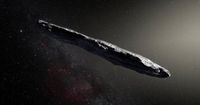The solar system is once again the stage for cosmic intrigue as scientists worldwide turn their telescopes toward a mysterious interstellar object, 3I/ATLAS, racing through space at a breathtaking 135,000 miles per hour. First detected on July 1, 2025, this enigmatic visitor has sparked heated debate among astronomers, with some calling it a comet, while others—most notably Harvard astrophysicist Avi Loeb—suggest it could be something far more extraordinary: an alien spacecraft.
What sets 3I/ATLAS apart from the usual cosmic debris isn’t just its speed or trajectory, but a series of peculiar observations that have left experts scratching their heads. According to News18, Loeb has argued that images captured by the Hubble Space Telescope on July 21 reveal a glow emanating from the object’s sun-facing side, but—strangely—no tail behind it. This is highly unusual for comets, which typically display a bright tail of dust and gas streaming away from the sun. The light, described as intense and sharply fading with distance, doesn’t match the expected pattern of sunlight reflecting off a dusty coma, the cloud that usually surrounds a comet’s core.
"3I/ATLAS could be a spacecraft powered by nuclear energy, and the dust emitted from its frontal surface might be from dirt that accumulated on its surface during its interstellar travel," Loeb wrote in a statement, as reported by The Express. He was quick to add, "This cannot be ruled out, but requires better evidence to be viable."
The object’s estimated size is another point of contention. Initial calculations put its length at around 12 miles, but Loeb and his colleague Eric Keto have suggested that if 3I/ATLAS is indeed generating its own light, it could be much smaller—perhaps only 300 feet long. This would make it comparable to Oumuamua, the first known interstellar object to pass through our solar system in 2017, which Loeb has also controversially argued could be an artificial probe.
Adding to the puzzle is 3I/ATLAS’s highly unusual trajectory. As Daily Express and News18 both note, the object is on a path that will take it close to not just one, but three planets: Venus, Mars, and Jupiter. The odds of a natural space rock randomly following such a course are less than 0.005 percent, according to Loeb. He’s gone so far as to speculate that the trajectory could be a "defensive maneuver," as if an intelligent craft were deliberately avoiding detection or seeking a panoramic survey of the solar system’s planets. "It could come to save us or to destroy us. We better be prepared for both possibilities and verify that all interstellar objects are just rocks," Loeb cautioned in comments reported by The Express.
Of course, the scientific community is far from united on these claims. Most astronomers, including Oxford’s Chris Lintott, have dismissed Loeb’s ideas. Lintott told Live Science that the alien probe theory is "absolute nonsense" and an "insult to the exciting work that is being done to understand this object." NASA, too, maintains that 3I/ATLAS is most likely a comet, albeit a peculiar one. They point out that comets can sometimes lose their tails as they approach the sun or behave unpredictably due to their icy, volatile nature. Still, the lack of a visible tail and coma continues to baffle many observers.
Loeb, undeterred by criticism, has compared the situation to a cosmic "Turing Test"—a challenge set by extraterrestrial intelligence to evaluate humanity’s scientific curiosity and imagination. In a recent blog post, he mused that if scientists simply dismiss 3I/ATLAS as another space rock, it might signal to advanced civilizations that humans lack the open-mindedness needed for interstellar recognition. "An encounter with an interstellar, alien technology is a blind date of astronomical proportions," Loeb told The Mail. "You don't know what you will meet, because our imagination is limited to our experience on Earth."
He even floated the idea of transmitting peaceful radio messages to the object—suggesting phrases like "peace" and "hello neighbour"—but later reconsidered, warning that such messages could be misinterpreted as threats by technologically superior visitors. Drawing an analogy, he said, "It’s like showing a caveman an iPhone." The implication? Extraterrestrials might find Earth’s attempts at contact either laughable or alarming.
For those keeping score, 3I/ATLAS is only the third known interstellar object to enter our solar system, following Oumuamua in 2017 and comet Borisov in 2019. Its arrival has reignited public fascination with the possibility of alien life, especially given the timing of other cosmic warnings: Stephen Hawking once predicted the dangers of contacting extraterrestrials, and NASA has issued its own alerts about unpredictable objects from beyond the solar system.
The timeline for 3I/ATLAS’s journey is as dramatic as its story. The object is expected to reach its closest point to the sun on October 30, 2025—just 130 million miles from Earth, according to NASA. Before that, it will briefly vanish behind the sun in September, making observations impossible until it reemerges in November or December. If it truly is an alien craft, as Loeb speculates, it could arrive near Earth between November 21 and December 5. But even if it’s just a comet, its peculiarities make it a subject of intense scientific scrutiny.
Scientists are eagerly awaiting the next opportunity to study 3I/ATLAS up close. On October 3, when it passes Mars, astronomers hope to capture higher-resolution images that could finally reveal the object’s true nature. Will it turn out to be a dusty, tail-less comet defying expectations, or could it be the first confirmed visitor from an alien civilization?
For now, 3I/ATLAS remains a cosmic riddle—one that has reignited debates about the boundaries of science, the courage to imagine, and humanity’s place in the universe. As telescopes track its path and experts argue over its origins, the world watches and waits, reminded that the universe is still full of surprises.

